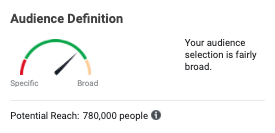Did you know that Facebook has an advertising audience of 2.14 billion people? According to M+R, small nonprofits spend 96 percent of their fundraising budget on social media. With such a huge pool of potential supporters, it's important to develop a strategy to reach the right people with the right message — at the right time.
As mentioned in our first post of this blog series, 6 Best Practices for Nonprofit Digital Advertising Success in 2021, social media algorithms are making it harder for organic posts to reach your followers. We already know that Facebook is a powerful tool for nonprofits to use to engage with their communities through organic posting. Paid advertising allows your nonprofit to significantly expand your reach to new users, therefore growing your online community.
As you dive deeper into social media advertising, there are some basics to know in order to implement a successful Facebook advertising campaign. These seven steps will get you on your way.

1. Determine Your Desired Outcome
Success with ad campaigns can mean different things to different organizations, depending on what the desired outcome is.
For beginners, it could simply be testing new audiences and your "creative" (an advertising term that refers to your messaging and visual assets). If you're unfamiliar with the Ads Manager, it could take time to become familiar and know what's best for you.
For experienced advertisers, success could be getting a cheap cost for clicks to their page or registrations for a virtual event.
So before you spend money, it's important to identify what you're hoping to get out of this campaign. Are you simply testing strategies to see what works and build your familiarity with Facebook ads? Are you aiming for a specific number of page visitors with a specific budget? This should be clearly identified and kept in mind from the very beginning.
2. Identify Your Target Audience
The Facebook Ads Manager allows many different ways to target users online. You're able to target people based on location, age, interests, job titles, and more. You can also create custom audiences based on email lists, engagement with your Facebook page, and more. From these custom audiences, you can then create look-alike audiences, which are brand-new audiences with the same habits and interests as your original custom audience.
The Ads Manager allows you to mix and match your criteria — including some and excluding others. Once you're actually building your audience, you'll be shown a meter to see the potential reach of your built audience. For this meter, the rule of thumb is to aim for the green zone.

3. Understand the Structure of the Ads Manager
The Ads Manager is full of features from building custom audiences to having a media library. Most importantly, it's crucial to understand the actual structure of the Ads Manager and what it takes to create an ad. In the Ads Manager, you'll see three different levels, or tabs: the Campaign Level, Ad Set Level, and Ad Level.
Campaign Level:
- The foundation of your campaign
- Where you select your specific objective
Ad Set Level:
- Where you define your target audience by choosing criteria such as location, gender, age, and interests
- Where you set your daily or overall budget
- Where you can set up a specific schedule for your ads
- Where you can choose your placements, such as the Facebook Newsfeed or Instagram
Ad Level:
- Where you put together the creative messaging and visual assets for your ad, including the body text and graphics or videos
Within your campaign, you're able to create multiple ad sets and ads, allowing you to test different variations of targeting and creative. From there, the Facebook algorithm will automatically focus on the creative that performs the best.
4. Choose the Right Objective
Before you even consider putting money into Facebook advertising, it's important to understand the possible objectives and which one will help you reach your goal. In the Facebook Ads Manager, the objectives are broken into three types: Awareness, Consideration, and Conversion. Below is a breakdown of each objective, taken directly from Facebook.
Awareness Objectives: Objectives that generate interest in your organization. Increasing brand awareness is about telling people what makes your business valuable.
| Objective | Goal |
|---|---|
| Brand Awareness | Increase people's awareness of your business, brand, or service. |
| Reach | Show your ad to as many people as possible in your target audience. |
Consideration Objectives: Objectives that get people to think about your business and seek more information.
| Objective | Goal |
|---|---|
| Traffic | Send people from Facebook to any URL you choose, such as your website's landing page, a blog post, app, etc. |
| Engagement | Reach people more likely to engage with your post. Engagement includes likes, comments, and shares but can also include offers claimed from your page. |
| App Installs | Send people to the store where they can download your business's app. |
| Video Views | Share videos of your business with people on Facebook most likely to watch it. |
| Lead Generation | Collect leads for your business. Create ads that collect info from people interested in your product, such as sign-ups for newsletters. |
| Messages | Connect with people on Messenger, Instagram Direct, and WhatsApp. Communicate with potential or existing customers to encourage interest in your business. |
Conversion Objectives: Objectives that encourage people interested in your business to buy or use your product or service.
| Objective | Goal |
|---|---|
| Conversions | Encourage people to take a specific action on your business's site, such as having them add items to a cart, download your app, register for your site, or make a purchase. |
| Catalog Sales | Show products from your e-commerce store's catalog to generate sales. |
| Store Traffic | Promote your brick-and-mortar business locations to people that are nearby. |
If you are working with a small budget, you may want to start off with a campaign objective of engagement. Facebook will target users most likely to engage with your ad with a like, comment, or share. Since it's easier to get engagement than a conversion or even a click, it is an affordable way to test your campaign and see what's resonating with your audience. This allows you to build social proof on your ad, signaling to Facebook that this is a quality post and therefore improving the ad performance. If you're happy with your results, the next step could be to reuse the creative by creating a new campaign with a more advanced objective, such as traffic or conversion.
Your Facebook pixel, which is a few lines of code from Facebook that you can copy into your website, will use all the data from your ads to optimize for future ads you create. Consider this a way to "train" your pixel to continue finding the right audiences to fulfill your campaign objectives.
5. Determine Your Budget
One reason why Facebook ads are an effective platform for nonprofits is because you can run campaigns for low costs. While it helps to spend more and reach more people, you can get started by testing your content with a simple traffic or engagement ad, with a budget as little as $5 or $10 a day. It only takes a few days to see if your ads are bringing in results. From there, you can adjust your budget based on what's working and what's not.
When you set up your campaign, you have the option of spending your money with CBO (campaign budget optimization) or ABO (ad set budget optimization).
CBO will automatically distribute your overall budget across ad sets to get more results, giving the artificial intelligence power to scale the ads based on what's bringing in the best results. Using CBO is gradually becoming more popular with advertisers, but some still prefer to keep full control over their budget and where their money goes.
For ABO, you select how much of your budget is spent on each ad set within your campaign. This gives you more flexibility to manually scale the ads and allows more control over the spending of each audience group.
Most users start their budget strategy with ABO as they test and see what works, guiding the AI to collect useful data. Once there's enough data established, many users then put it completely in the AI's hands, going with CBO.
6. Draft Your Creative
In order to run an ad, you need the proper messaging and images or videos to go with it. These are types of ad creative:
- Body text
- Headline
- Ad description
- Images or videos
If your budget allows space for testing, it's always recommended to draft up a few different variations of your creative to test and see what works best. Within your ad set, you can run multiple ads, in which the algorithm will test and focus your budget on the ad getting the most engagement.
7. Know How to Evaluate Your Results
When you're initially putting an ad out, it'll first go through Facebook's "learning phase." This is where the Facebook algorithm will identify your ad's initial engagement and then build a statistical model to bring in similar results. Typically after 48 to 72 hours, you'll have a good indication of whether the algorithm is learning properly. Otherwise it could be worth going back to the drawing board and testing a few different strategies.
If you're getting results after a few days, see what you can analyze. Is one placement performing better than the other? Is one audience bringing in cheaper results? Based on these findings, adjust your campaign and make sure your budget is going towards the right assets.
If your nonprofit hasn't invested in Facebook advertising to get your word out and grow your community, it is worth trying. And while these steps only scratch the surface of the social media advertising world, they're important steps to keep in mind when you want to implement a successful Facebook advertising campaign.
Additional Resources
- Take advantage of TechSoup's Digital Marketing Services for Nonprofits.
- Take Techsoup Courses' Google Ad Grant Seminar Series.
- Look into Are Digital Ads the Missing Piece in Your Marketing Plan?
- Find out How Can Facebook Analytics and Insights Help Your Nonprofit?







